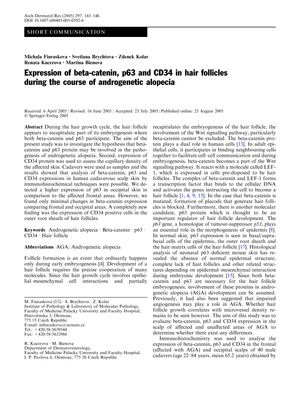Expression of Beta-Catenin, p63, and CD34 in Hair Follicles During the Course of Androgenetic Alopecia
August 2005
in “
Archives of Dermatological Research
”

TLDR Higher p63 and CD34 levels found in specific scalp areas may affect hair loss progression.
This study examined the expression of beta-catenin, p63, and CD34 in hair follicles of patients with androgenetic alopecia (AGA). The study found that p63 expression was higher in occipital skin compared to frontal areas, suggesting that p63 may participate in AGA progression. Additionally, CD34 expression was more frequent in occipital hair follicles. The study did not find significant differences in beta-catenin expression between frontal and occipital scalp. The study suggests that basic molecular mechanisms that govern hair follicle development might be applicable to postnatal, cycling hair.


